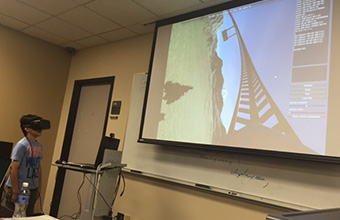College of Arts and Sciences Newsroom

Virtual Roller Coaster
"Remain seated and keep your hands inside the ride at all times" is something you might hear at a theme park, not a computer programming class. But University of Dayton students may want to heed that warning this fall, when learning the basics of programming rises to dizzying new heights.
Mehdi Zargham, chair of the department of computer science, and his student, Bharat Kamsani, have developed new technology that allows students with no prior programming skills to design a roller coaster in a 3-D visual environment and then “ride” their creation wearing a virtual reality headset.
Zargham said the technology provides a visual teaching method for programming that reduces complexity and makes it fun for students of all ages. The ultimate goal is to increase computer science enrollment and retention rates, especially among female and underserved students.
“We want everyone to be able to do programming in the simplest way,” he said. “They can visualize their code at the same time they are programming. More than that, they can also enjoy what they have designed.”
Unlike writing complex code, students stack simple assignment and control statements that define the length, angle and direction of each section of roller coaster track. The students see the track being created with each new statement, while learning the concepts of problem-solving and flow-charting a sequence of events.
When the track is complete, students can experience their creation in a virtual world, as if they were riding the Beast or Vortex at Kings Island theme park.
“You are really interacting with your code, rather than just watching it on a 2-D screen,” Zargham said. “That is what separates it from the typical way of teaching.”
Zargham developed the programming in a virtual environment tool under a highly competitive $300,000 grant to the University from the Association of American Colleges and Universities to improve diversity among students in its computer science program.
He plans to test the technology with students this fall in an introductory computer science course created under the same AACU grant.
The University was one of 14 institutions to receive AACU funding for its “TIDES” initiative — Teaching to Increase Diversity and Equity in STEM. The three-year initiative hopes to increase the success and retention of students historically underrepresented in the computer and information sciences, and other related science, technology, engineering and mathematics disciplines.
“As an institution, we are in the leadership role to demonstrate not only proof of concept, but also to create exportable practices and models that will be able to be used in computer science education at institutions all over the world,” said Don Pair, College of Arts and Sciences associate dean.
Pair said the programming tool may be a commercially viable product.
Zargham, Pair and Zhongmei Yao, associate professor of computer science, demonstrated the virtual roller coaster project and discussed other grant-related activities at the TIDES Institute III workshop, June 27-July 1, in Washington, D.C.
Under AACU funding, the University launched a new introductory computer science course in fall 2014 to serve students who are interested in majoring in computer science, but who may not be ready for entry-level programming classes. The course focuses on problem solving, creating animation applications in a simple programming environment, and working on group projects.
In addition, computer science faculty have attended TIDES workshops to learn about culturally inclusive teaching approaches and unconscious biases.
“In order to change the atmosphere of the classroom, you have to really help faculty see that the way they teach has a profound impact on the way students learn,” Pair said.
Those innovations are already having an impact on student success, according to an independent evaluator’s report and University data.
An external evaluation by a professional consultant from Wright State University found students who completed the University of Dayton’s new introductory computer science course during the fall 2015 semester reported feeling more connected to their peers, supported by faculty, engaged in their coursework and confident to pursue a career in a computer science field.
University of Dayton undergraduate enrollment in computer science programs has nearly doubled from fall 2012 to fall 2016, while the number of students leaving those programs dropped by 50 percent during the last four academic years.
Now, Zargham’s virtual roller coaster could potentially benefit the entire computer science community, from higher education down to the K-12 level. He hopes in the near future, students will be able to code the design of other virtual environments through their own imagination.
“You get to know programming and you enjoy it, so hopefully you go on and advance in other computer languages,” Zargham said.
- Dave Larsen, communication coordinator, College of Arts and Sciences
